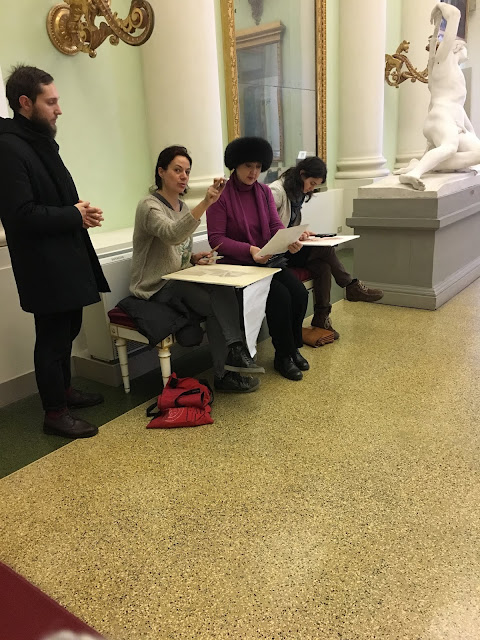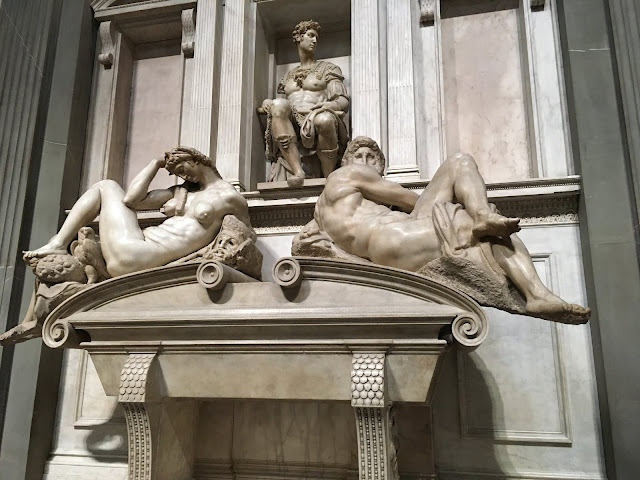The House of Medici, the wealthy family dynasty of bankers and politicians, dominated Florence for most of 300 years. The influence of the family as patrons of the arts is seen all over Florence. They are credited with being central in inspiring the Italian Renaissance through their patronage of Botticelli, Leonardo da Vinci, Michaelangelo, Machiavelli, Galileo, and many others. In the middle of the 16th century, the Medici family purchased Palazzo Pitti as an additional residence to the Palazzo Vecchio. The Medici eventually made it their primary residence and expanded it to house their collection of art. Located a short distance from the Ponte Vecchio, on the south side of the Arno River, it's not particularly impressive from the outside, in my opinion; however, inside it now houses the largest museum complex in Florence.
Today, the museum is an amazing treasure house of the Medici and others' collections of paintings, sculptures, jewelry, plates, furnishings, and all manner of beautiful objects. Can you imagine this ceiling in your home? I wonder what they do about cobwebs.
Looking up is pretty important, since a lot of the art is on the ceilings or high up on the walls. It seems that the principle of hanging art work at viewing height wasn't in existence here.
This urn is much taller than I am.
I just love the colors of this inlaid table top.
This sculpture reminds me a little of Vigeland's Angry Child at Frogner Park in Oslo.
I'm sure this one is familiar -- Ecce Homo (Behold the Man) by Antonio Ciseri.
M
Here's a bust of the composer Giuseppe Verdi.
And a sculpture of the author Victor Hugo.
This interesting sculpture caught my eye. It was created from black ceramic in 1935 by Renato Bertelli and is called Head of Mussolini. It's a "continuous profile" because no matter which angle you view it from, it's the same.
A little different take on "knitting."
And finally, some of the furnished rooms -- a throne room and bedroom. Notice the candles. What a beautiful atmosphere they would create at night when lit!
From the windows in the palace, there are beautiful views of the Boboli gardens and Florence. I think it's interesting and unusual that the gardens are higher than the palace.
On the other side of the Arno River, the Medici were instrumental in creating the Medici Chapels, part of the complex of the Basilica of San Lorenzo. They were built in the 16th and 17th centuries as extensions to Brunelleschi's 15th century church, seen in the next four photos.
Of the two chapels, the larger Chapel of the Princes was a collaborative design between the Medici patrons and several architects. Restoration work was being done in sections of this chapel, with scaffolding in place, so I tried to avoid that in my photos. Michaelangelo designed the smaller New Sacristy chapel.
The sarcophagi are empty since the Medici family are actually buried in the crypt below the church.
The smaller New Sacristy Chapel, designed by Michaelangelo (his first attempt at architecture) also has tombs commissioned by the Medici for their burials. The original plan was for four tombs to be built, but only two were completed. The four times of day are represented by the figures sculpted on these tombs -- Day and Night on the tomb built for Guilliano de Lorenzo d'Medici, and Dusk and Dawn on the tomb built for Lorenzo di Piero.
Through the courtyard to the Basilica, one can enter the crypt. Here is also the tomb of the Donatello with the plaque below.
A small museum holding some of the treasured "holy" relics collected by Medici family members is also in the San Lorenzo Basilica and Medici Chapels complex. Victoria della Rovere, Grand Duchess of Tuscany from 1637-1694 and wife of the Grand Duke Ferdinando II de' Medici, inherited the Chapel of Relics in Palazzo Pitti from Grand Duchess Christine of Lorraine and Maria Magdalena of Austria. (Relics, you may remember, are physical remains or personal belongings of saints and other revered persons preserved for the purpose of venerating that person.) She added to this collection and had beautiful and valuable containers, reliquaries, for these remains made which are on display here. If you look closely, you'll see that each houses a bone or skull or even skeleton. An interesting side note, my husband's grandfather's mother's family name was Rovere. Could he be a descendent of the Medici family?
Look closely at the darker place in this casket in the upper left half of the photo and you'll see the skull of what appears to be most of a skeleton.
The last church we visited in Florence was the church of Santa Croce (or Holy Cross). It's beautiful in its own right, but famous as the burial place of many Florentine greats.
The tomb of Dante
The tomb of Michaelangelo
The tomb of Galileo
Requiescet in pace. May they rest in peace.




















































No comments:
Post a Comment